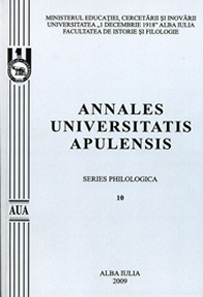Syllabus Design
Syllabus Design
Author(s): Ema Ileana Adam, Marinela GranescuSubject(s): Foreign languages learning
Published by: Universitatea »1 Decembrie 1918« Alba Iulia
Keywords: syllabus design approaches; undergraduates; graduates; Master courses
Summary/Abstract: Since the 1960s, English for Specific Purposes (ESP) has become a vital and innovative activity within the teaching of English as a foreign or second language movement. ESP is regarded as an “approach” not as a “product” and the learner-centeredness of ESP underlines both the concept of approach and of communication, Based on this point of view, ESP instructors characteristically use problem-solving methods and techniques to promote the appropriate communicative development of individuals in particular contexts of implementation and design syllabi considering the specific and differing role of the ESP teacher. Commonly, ESP teachers and practitioners have many roles from a course designer, a material provider, to a facilitator, a consultant, a coordinator, an evaluator, and even a project researcher. These roles change the approach to language teaching in which all decisions as to content and method are based on the learner’s reason for learning. Designing a course syllabus represents a complex, time-consuming and difficult process, especially when the undergraduates and graduates aimed at present various levels of language command. In making practical decisions about syllabus design, one must take into consideration all the possible factors that might affect whether or not a particular syllabus can be taught. Teachability of a particular syllabus seems to be one of the most often met concerns of a teacher. That is why designing syllabi with a student centred approach normally starts with an examination of each syllabus type, tailoring the choice and integration of the different types according to local needs so as to find a practical solution to the problem of appropriateness and effectiveness in syllabus design. It is clear that no single type of content is appropriate for all teaching settings, and the needs and conditions of each setting are so different and varied that specific recommendations cannot be followed without considering constraints. Clearly, there is a vast amount of material to discuss, use and disseminate when considering syllabus design. All the numerous approaches offer valuable insights into creating a language program. The synthetic approaches of structuralism, situational and functional-notional, all have objectives to be attained, a content to be processed and learnt. The foundations of the product syllabuses remain fundamentally similar, whereas the underlying assumptions about language and language learning from the analytic approaches differ greatly: process type syllabuses assert that learning a language is transient and cannot be itemized; pedagogical procedure takes precedence over content. In the context of ESP syllabi, interdisciplinarity and transdisciplinarity have a great contribution to the research oriented to practical achievements.
Journal: Annales Universitatis Apulensis. Series Philologica
- Issue Year: 11/2010
- Issue No: 2
- Page Range: 244-254
- Page Count: 11
- Language: English

